Financial Decision Making Report: Skanska plc, Accounting and Finance
VerifiedAdded on 2022/12/01
|13
|3429
|420
Report
AI Summary
This report provides a comprehensive analysis of financial decision-making, focusing on Skanska plc, a construction and development company. The report begins with an introduction to the company, its operations, and its financial performance. It then delves into the importance of accounting and finance functions within the organization, detailing their roles and responsibilities. The report highlights the significance of financial statements, including the income statement, balance sheet, and cash flow statement, and explains how these statements are used to assess a company's financial health. Furthermore, the report includes a detailed analysis of key financial ratios such as Return on Capital Employed (ROCE), Net Profit Margin, and Current Ratio, providing interpretations and insights into Skanska plc's financial performance over two years. The report also explores various accounting techniques used by the company. Overall, the report offers a thorough examination of Skanska plc's financial strategies and performance, providing valuable insights for understanding financial decision-making in a real-world business context.

Financial Decision
Making
Making
Paraphrase This Document
Need a fresh take? Get an instant paraphrase of this document with our AI Paraphraser

Table of Contents
Introduction-................................................................................................................................................3
Task -1.........................................................................................................................................................3
Task – 2.......................................................................................................................................................8
Conclusion-.................................................................................................................................................9
References-..................................................................................................................................................9
Introduction-................................................................................................................................................3
Task -1.........................................................................................................................................................3
Task – 2.......................................................................................................................................................8
Conclusion-.................................................................................................................................................9
References-..................................................................................................................................................9
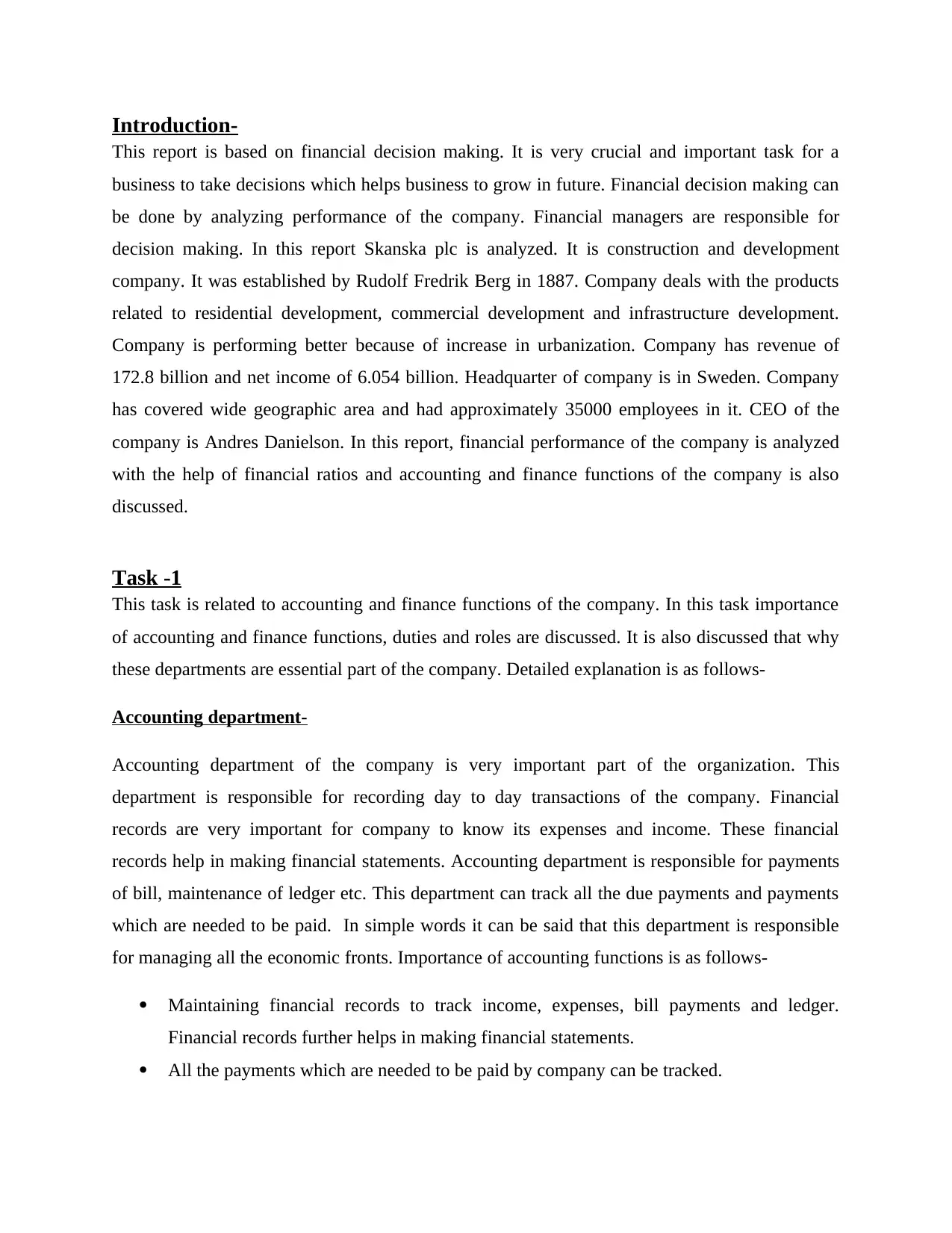
Introduction-
This report is based on financial decision making. It is very crucial and important task for a
business to take decisions which helps business to grow in future. Financial decision making can
be done by analyzing performance of the company. Financial managers are responsible for
decision making. In this report Skanska plc is analyzed. It is construction and development
company. It was established by Rudolf Fredrik Berg in 1887. Company deals with the products
related to residential development, commercial development and infrastructure development.
Company is performing better because of increase in urbanization. Company has revenue of
172.8 billion and net income of 6.054 billion. Headquarter of company is in Sweden. Company
has covered wide geographic area and had approximately 35000 employees in it. CEO of the
company is Andres Danielson. In this report, financial performance of the company is analyzed
with the help of financial ratios and accounting and finance functions of the company is also
discussed.
Task -1
This task is related to accounting and finance functions of the company. In this task importance
of accounting and finance functions, duties and roles are discussed. It is also discussed that why
these departments are essential part of the company. Detailed explanation is as follows-
Accounting department-
Accounting department of the company is very important part of the organization. This
department is responsible for recording day to day transactions of the company. Financial
records are very important for company to know its expenses and income. These financial
records help in making financial statements. Accounting department is responsible for payments
of bill, maintenance of ledger etc. This department can track all the due payments and payments
which are needed to be paid. In simple words it can be said that this department is responsible
for managing all the economic fronts. Importance of accounting functions is as follows-
Maintaining financial records to track income, expenses, bill payments and ledger.
Financial records further helps in making financial statements.
All the payments which are needed to be paid by company can be tracked.
This report is based on financial decision making. It is very crucial and important task for a
business to take decisions which helps business to grow in future. Financial decision making can
be done by analyzing performance of the company. Financial managers are responsible for
decision making. In this report Skanska plc is analyzed. It is construction and development
company. It was established by Rudolf Fredrik Berg in 1887. Company deals with the products
related to residential development, commercial development and infrastructure development.
Company is performing better because of increase in urbanization. Company has revenue of
172.8 billion and net income of 6.054 billion. Headquarter of company is in Sweden. Company
has covered wide geographic area and had approximately 35000 employees in it. CEO of the
company is Andres Danielson. In this report, financial performance of the company is analyzed
with the help of financial ratios and accounting and finance functions of the company is also
discussed.
Task -1
This task is related to accounting and finance functions of the company. In this task importance
of accounting and finance functions, duties and roles are discussed. It is also discussed that why
these departments are essential part of the company. Detailed explanation is as follows-
Accounting department-
Accounting department of the company is very important part of the organization. This
department is responsible for recording day to day transactions of the company. Financial
records are very important for company to know its expenses and income. These financial
records help in making financial statements. Accounting department is responsible for payments
of bill, maintenance of ledger etc. This department can track all the due payments and payments
which are needed to be paid. In simple words it can be said that this department is responsible
for managing all the economic fronts. Importance of accounting functions is as follows-
Maintaining financial records to track income, expenses, bill payments and ledger.
Financial records further helps in making financial statements.
All the payments which are needed to be paid by company can be tracked.
⊘ This is a preview!⊘
Do you want full access?
Subscribe today to unlock all pages.

Trusted by 1+ million students worldwide
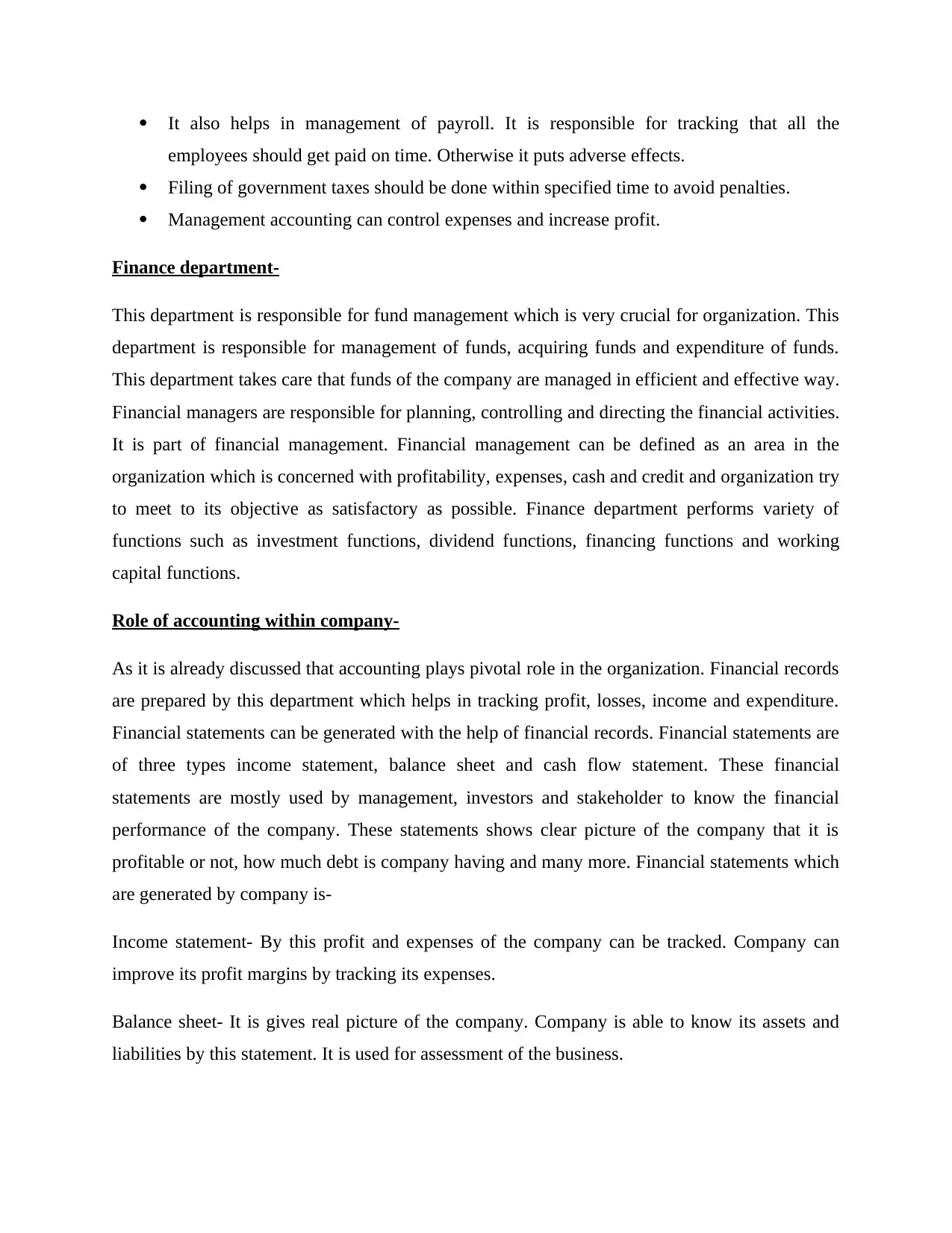
It also helps in management of payroll. It is responsible for tracking that all the
employees should get paid on time. Otherwise it puts adverse effects.
Filing of government taxes should be done within specified time to avoid penalties.
Management accounting can control expenses and increase profit.
Finance department-
This department is responsible for fund management which is very crucial for organization. This
department is responsible for management of funds, acquiring funds and expenditure of funds.
This department takes care that funds of the company are managed in efficient and effective way.
Financial managers are responsible for planning, controlling and directing the financial activities.
It is part of financial management. Financial management can be defined as an area in the
organization which is concerned with profitability, expenses, cash and credit and organization try
to meet to its objective as satisfactory as possible. Finance department performs variety of
functions such as investment functions, dividend functions, financing functions and working
capital functions.
Role of accounting within company-
As it is already discussed that accounting plays pivotal role in the organization. Financial records
are prepared by this department which helps in tracking profit, losses, income and expenditure.
Financial statements can be generated with the help of financial records. Financial statements are
of three types income statement, balance sheet and cash flow statement. These financial
statements are mostly used by management, investors and stakeholder to know the financial
performance of the company. These statements shows clear picture of the company that it is
profitable or not, how much debt is company having and many more. Financial statements which
are generated by company is-
Income statement- By this profit and expenses of the company can be tracked. Company can
improve its profit margins by tracking its expenses.
Balance sheet- It is gives real picture of the company. Company is able to know its assets and
liabilities by this statement. It is used for assessment of the business.
employees should get paid on time. Otherwise it puts adverse effects.
Filing of government taxes should be done within specified time to avoid penalties.
Management accounting can control expenses and increase profit.
Finance department-
This department is responsible for fund management which is very crucial for organization. This
department is responsible for management of funds, acquiring funds and expenditure of funds.
This department takes care that funds of the company are managed in efficient and effective way.
Financial managers are responsible for planning, controlling and directing the financial activities.
It is part of financial management. Financial management can be defined as an area in the
organization which is concerned with profitability, expenses, cash and credit and organization try
to meet to its objective as satisfactory as possible. Finance department performs variety of
functions such as investment functions, dividend functions, financing functions and working
capital functions.
Role of accounting within company-
As it is already discussed that accounting plays pivotal role in the organization. Financial records
are prepared by this department which helps in tracking profit, losses, income and expenditure.
Financial statements can be generated with the help of financial records. Financial statements are
of three types income statement, balance sheet and cash flow statement. These financial
statements are mostly used by management, investors and stakeholder to know the financial
performance of the company. These statements shows clear picture of the company that it is
profitable or not, how much debt is company having and many more. Financial statements which
are generated by company is-
Income statement- By this profit and expenses of the company can be tracked. Company can
improve its profit margins by tracking its expenses.
Balance sheet- It is gives real picture of the company. Company is able to know its assets and
liabilities by this statement. It is used for assessment of the business.
Paraphrase This Document
Need a fresh take? Get an instant paraphrase of this document with our AI Paraphraser
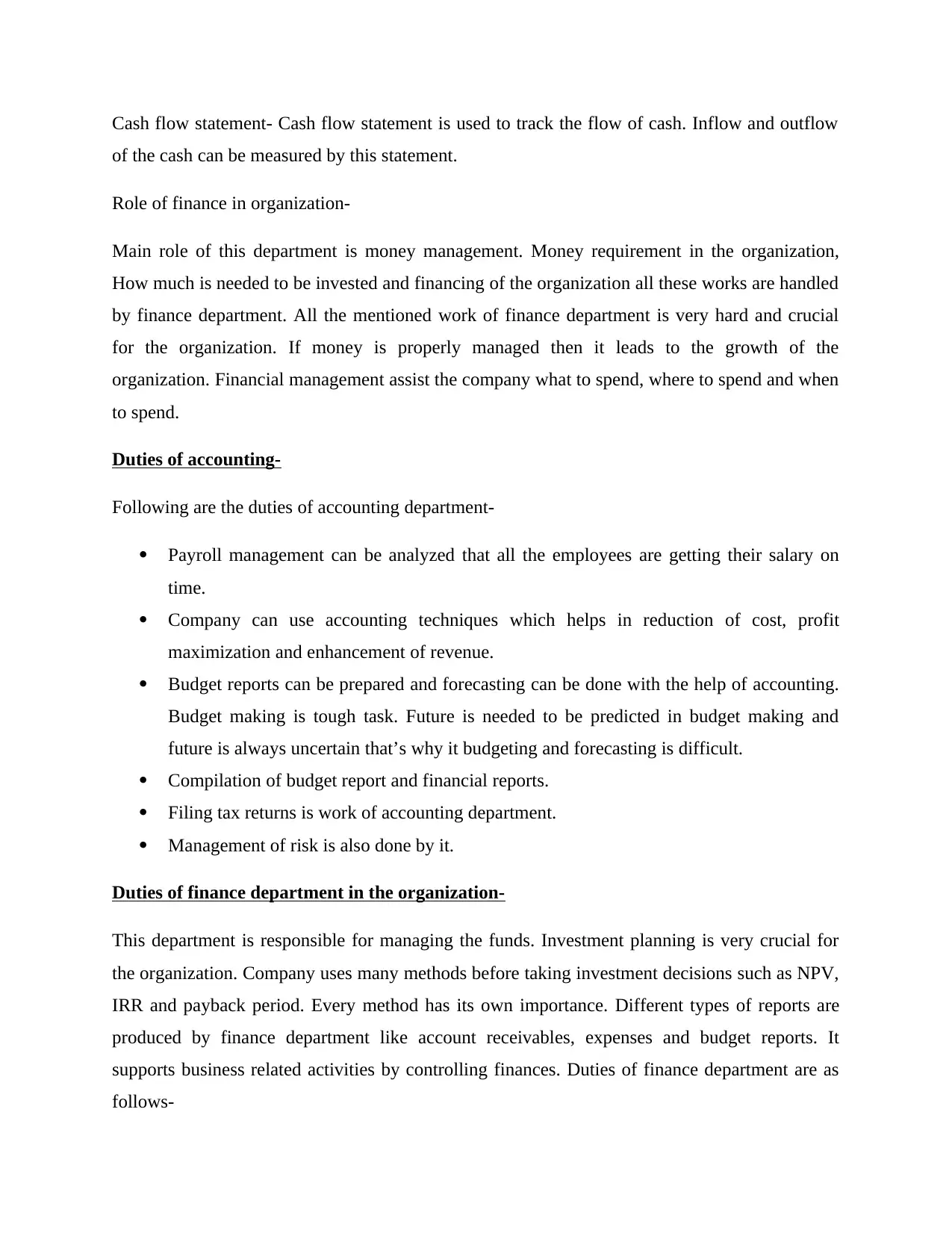
Cash flow statement- Cash flow statement is used to track the flow of cash. Inflow and outflow
of the cash can be measured by this statement.
Role of finance in organization-
Main role of this department is money management. Money requirement in the organization,
How much is needed to be invested and financing of the organization all these works are handled
by finance department. All the mentioned work of finance department is very hard and crucial
for the organization. If money is properly managed then it leads to the growth of the
organization. Financial management assist the company what to spend, where to spend and when
to spend.
Duties of accounting-
Following are the duties of accounting department-
Payroll management can be analyzed that all the employees are getting their salary on
time.
Company can use accounting techniques which helps in reduction of cost, profit
maximization and enhancement of revenue.
Budget reports can be prepared and forecasting can be done with the help of accounting.
Budget making is tough task. Future is needed to be predicted in budget making and
future is always uncertain that’s why it budgeting and forecasting is difficult.
Compilation of budget report and financial reports.
Filing tax returns is work of accounting department.
Management of risk is also done by it.
Duties of finance department in the organization-
This department is responsible for managing the funds. Investment planning is very crucial for
the organization. Company uses many methods before taking investment decisions such as NPV,
IRR and payback period. Every method has its own importance. Different types of reports are
produced by finance department like account receivables, expenses and budget reports. It
supports business related activities by controlling finances. Duties of finance department are as
follows-
of the cash can be measured by this statement.
Role of finance in organization-
Main role of this department is money management. Money requirement in the organization,
How much is needed to be invested and financing of the organization all these works are handled
by finance department. All the mentioned work of finance department is very hard and crucial
for the organization. If money is properly managed then it leads to the growth of the
organization. Financial management assist the company what to spend, where to spend and when
to spend.
Duties of accounting-
Following are the duties of accounting department-
Payroll management can be analyzed that all the employees are getting their salary on
time.
Company can use accounting techniques which helps in reduction of cost, profit
maximization and enhancement of revenue.
Budget reports can be prepared and forecasting can be done with the help of accounting.
Budget making is tough task. Future is needed to be predicted in budget making and
future is always uncertain that’s why it budgeting and forecasting is difficult.
Compilation of budget report and financial reports.
Filing tax returns is work of accounting department.
Management of risk is also done by it.
Duties of finance department in the organization-
This department is responsible for managing the funds. Investment planning is very crucial for
the organization. Company uses many methods before taking investment decisions such as NPV,
IRR and payback period. Every method has its own importance. Different types of reports are
produced by finance department like account receivables, expenses and budget reports. It
supports business related activities by controlling finances. Duties of finance department are as
follows-
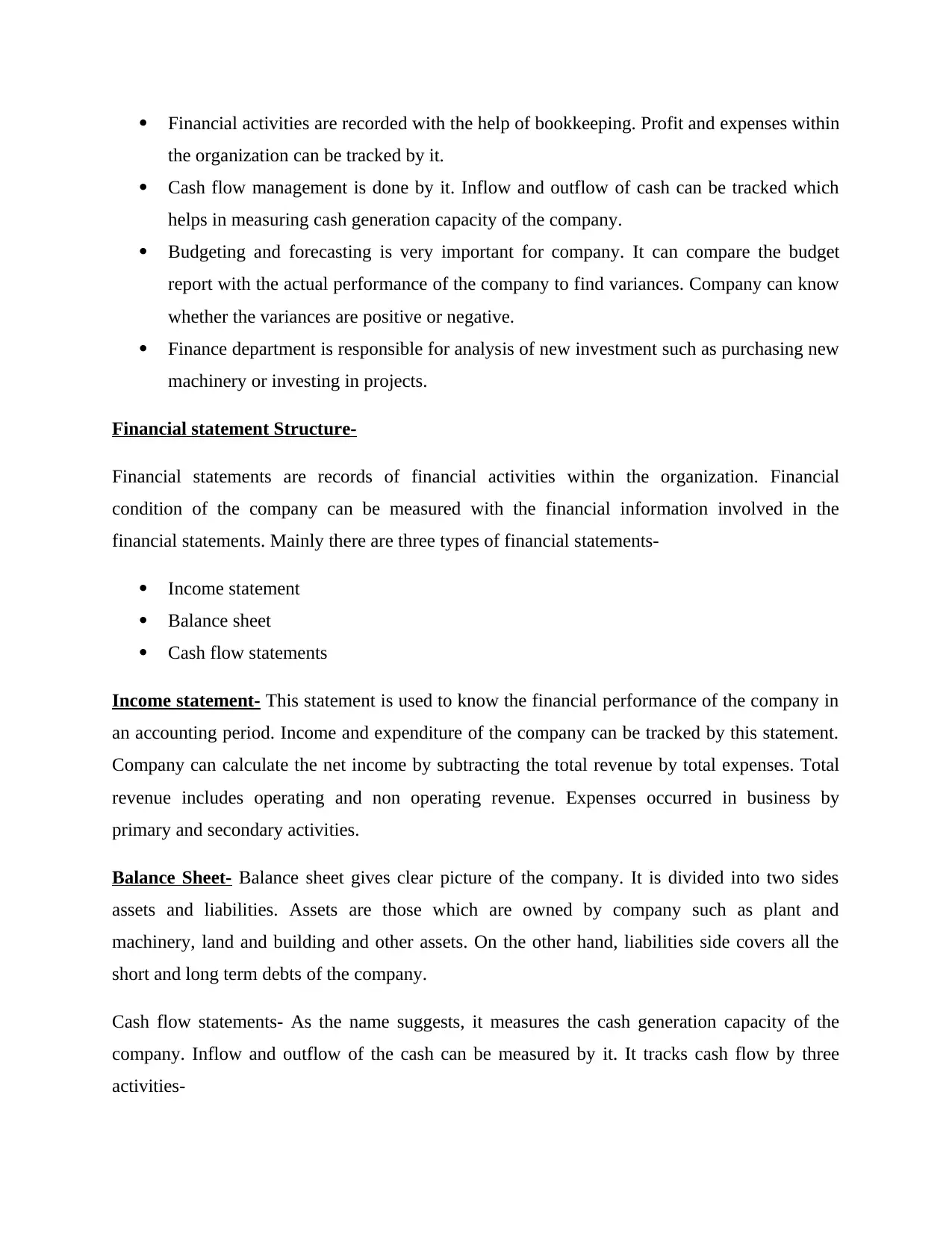
Financial activities are recorded with the help of bookkeeping. Profit and expenses within
the organization can be tracked by it.
Cash flow management is done by it. Inflow and outflow of cash can be tracked which
helps in measuring cash generation capacity of the company.
Budgeting and forecasting is very important for company. It can compare the budget
report with the actual performance of the company to find variances. Company can know
whether the variances are positive or negative.
Finance department is responsible for analysis of new investment such as purchasing new
machinery or investing in projects.
Financial statement Structure-
Financial statements are records of financial activities within the organization. Financial
condition of the company can be measured with the financial information involved in the
financial statements. Mainly there are three types of financial statements-
Income statement
Balance sheet
Cash flow statements
Income statement- This statement is used to know the financial performance of the company in
an accounting period. Income and expenditure of the company can be tracked by this statement.
Company can calculate the net income by subtracting the total revenue by total expenses. Total
revenue includes operating and non operating revenue. Expenses occurred in business by
primary and secondary activities.
Balance Sheet- Balance sheet gives clear picture of the company. It is divided into two sides
assets and liabilities. Assets are those which are owned by company such as plant and
machinery, land and building and other assets. On the other hand, liabilities side covers all the
short and long term debts of the company.
Cash flow statements- As the name suggests, it measures the cash generation capacity of the
company. Inflow and outflow of the cash can be measured by it. It tracks cash flow by three
activities-
the organization can be tracked by it.
Cash flow management is done by it. Inflow and outflow of cash can be tracked which
helps in measuring cash generation capacity of the company.
Budgeting and forecasting is very important for company. It can compare the budget
report with the actual performance of the company to find variances. Company can know
whether the variances are positive or negative.
Finance department is responsible for analysis of new investment such as purchasing new
machinery or investing in projects.
Financial statement Structure-
Financial statements are records of financial activities within the organization. Financial
condition of the company can be measured with the financial information involved in the
financial statements. Mainly there are three types of financial statements-
Income statement
Balance sheet
Cash flow statements
Income statement- This statement is used to know the financial performance of the company in
an accounting period. Income and expenditure of the company can be tracked by this statement.
Company can calculate the net income by subtracting the total revenue by total expenses. Total
revenue includes operating and non operating revenue. Expenses occurred in business by
primary and secondary activities.
Balance Sheet- Balance sheet gives clear picture of the company. It is divided into two sides
assets and liabilities. Assets are those which are owned by company such as plant and
machinery, land and building and other assets. On the other hand, liabilities side covers all the
short and long term debts of the company.
Cash flow statements- As the name suggests, it measures the cash generation capacity of the
company. Inflow and outflow of the cash can be measured by it. It tracks cash flow by three
activities-
⊘ This is a preview!⊘
Do you want full access?
Subscribe today to unlock all pages.

Trusted by 1+ million students worldwide
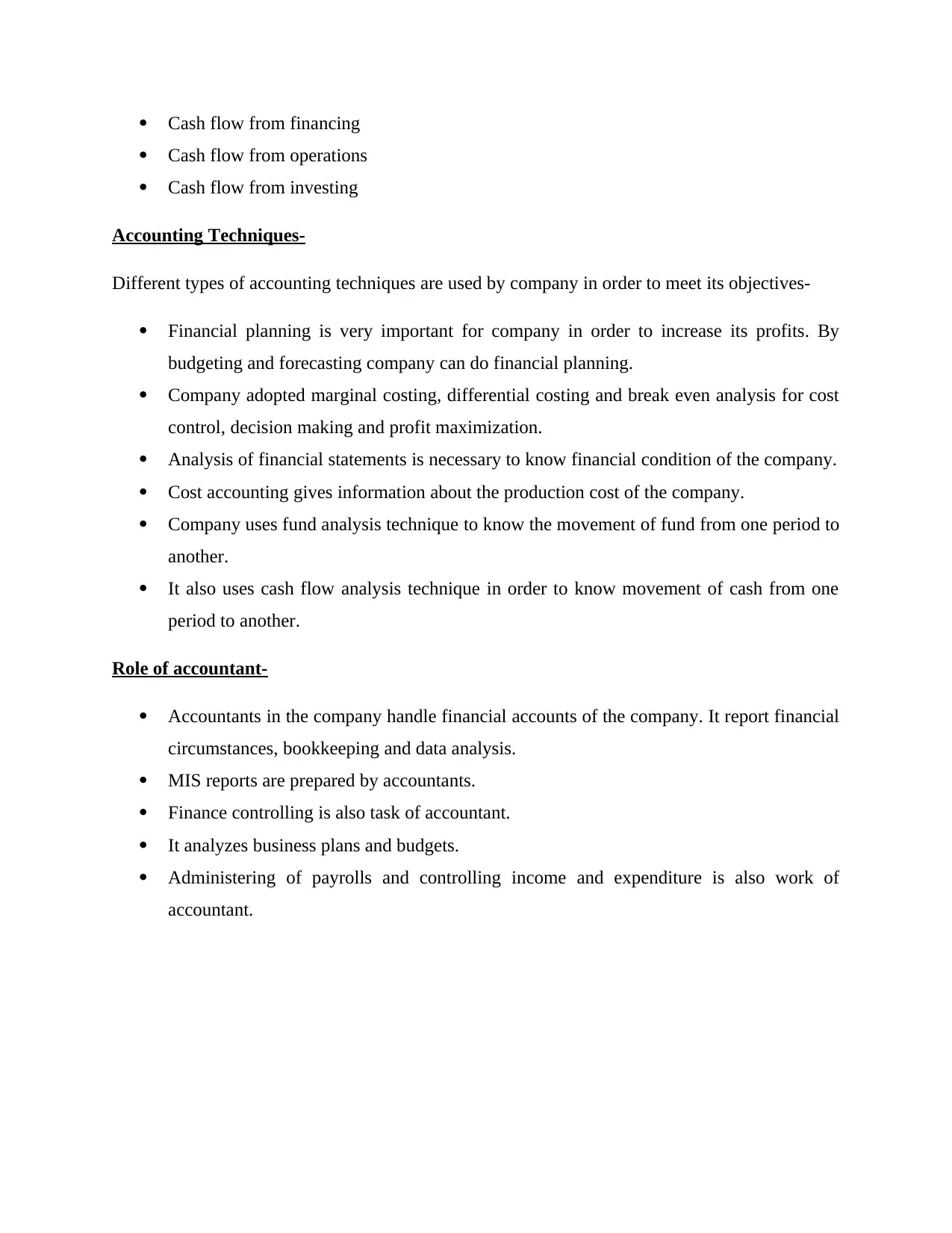
Cash flow from financing
Cash flow from operations
Cash flow from investing
Accounting Techniques-
Different types of accounting techniques are used by company in order to meet its objectives-
Financial planning is very important for company in order to increase its profits. By
budgeting and forecasting company can do financial planning.
Company adopted marginal costing, differential costing and break even analysis for cost
control, decision making and profit maximization.
Analysis of financial statements is necessary to know financial condition of the company.
Cost accounting gives information about the production cost of the company.
Company uses fund analysis technique to know the movement of fund from one period to
another.
It also uses cash flow analysis technique in order to know movement of cash from one
period to another.
Role of accountant-
Accountants in the company handle financial accounts of the company. It report financial
circumstances, bookkeeping and data analysis.
MIS reports are prepared by accountants.
Finance controlling is also task of accountant.
It analyzes business plans and budgets.
Administering of payrolls and controlling income and expenditure is also work of
accountant.
Cash flow from operations
Cash flow from investing
Accounting Techniques-
Different types of accounting techniques are used by company in order to meet its objectives-
Financial planning is very important for company in order to increase its profits. By
budgeting and forecasting company can do financial planning.
Company adopted marginal costing, differential costing and break even analysis for cost
control, decision making and profit maximization.
Analysis of financial statements is necessary to know financial condition of the company.
Cost accounting gives information about the production cost of the company.
Company uses fund analysis technique to know the movement of fund from one period to
another.
It also uses cash flow analysis technique in order to know movement of cash from one
period to another.
Role of accountant-
Accountants in the company handle financial accounts of the company. It report financial
circumstances, bookkeeping and data analysis.
MIS reports are prepared by accountants.
Finance controlling is also task of accountant.
It analyzes business plans and budgets.
Administering of payrolls and controlling income and expenditure is also work of
accountant.
Paraphrase This Document
Need a fresh take? Get an instant paraphrase of this document with our AI Paraphraser
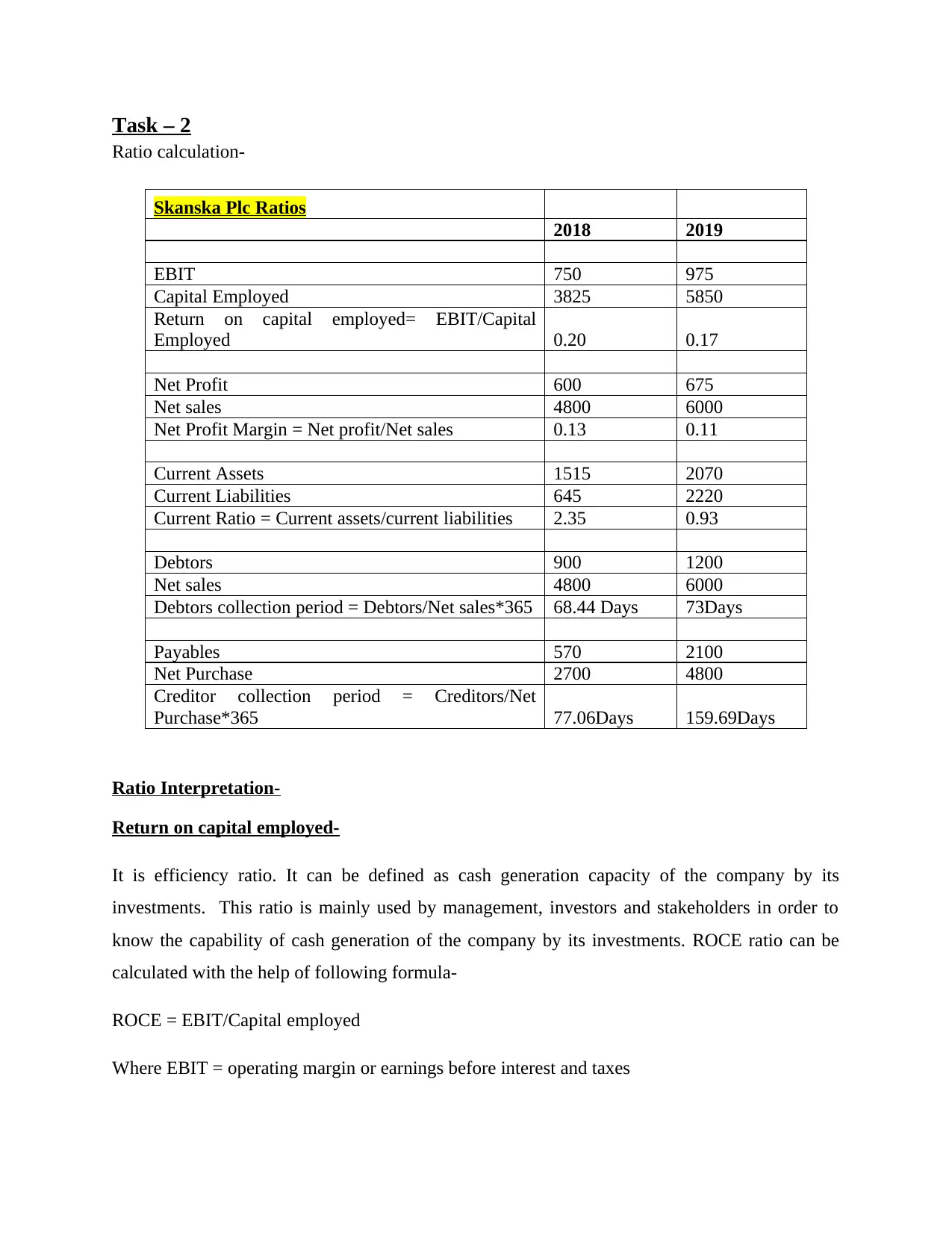
Task – 2
Ratio calculation-
Skanska Plc Ratios
2018 2019
EBIT 750 975
Capital Employed 3825 5850
Return on capital employed= EBIT/Capital
Employed 0.20 0.17
Net Profit 600 675
Net sales 4800 6000
Net Profit Margin = Net profit/Net sales 0.13 0.11
Current Assets 1515 2070
Current Liabilities 645 2220
Current Ratio = Current assets/current liabilities 2.35 0.93
Debtors 900 1200
Net sales 4800 6000
Debtors collection period = Debtors/Net sales*365 68.44 Days 73Days
Payables 570 2100
Net Purchase 2700 4800
Creditor collection period = Creditors/Net
Purchase*365 77.06Days 159.69Days
Ratio Interpretation-
Return on capital employed-
It is efficiency ratio. It can be defined as cash generation capacity of the company by its
investments. This ratio is mainly used by management, investors and stakeholders in order to
know the capability of cash generation of the company by its investments. ROCE ratio can be
calculated with the help of following formula-
ROCE = EBIT/Capital employed
Where EBIT = operating margin or earnings before interest and taxes
Ratio calculation-
Skanska Plc Ratios
2018 2019
EBIT 750 975
Capital Employed 3825 5850
Return on capital employed= EBIT/Capital
Employed 0.20 0.17
Net Profit 600 675
Net sales 4800 6000
Net Profit Margin = Net profit/Net sales 0.13 0.11
Current Assets 1515 2070
Current Liabilities 645 2220
Current Ratio = Current assets/current liabilities 2.35 0.93
Debtors 900 1200
Net sales 4800 6000
Debtors collection period = Debtors/Net sales*365 68.44 Days 73Days
Payables 570 2100
Net Purchase 2700 4800
Creditor collection period = Creditors/Net
Purchase*365 77.06Days 159.69Days
Ratio Interpretation-
Return on capital employed-
It is efficiency ratio. It can be defined as cash generation capacity of the company by its
investments. This ratio is mainly used by management, investors and stakeholders in order to
know the capability of cash generation of the company by its investments. ROCE ratio can be
calculated with the help of following formula-
ROCE = EBIT/Capital employed
Where EBIT = operating margin or earnings before interest and taxes
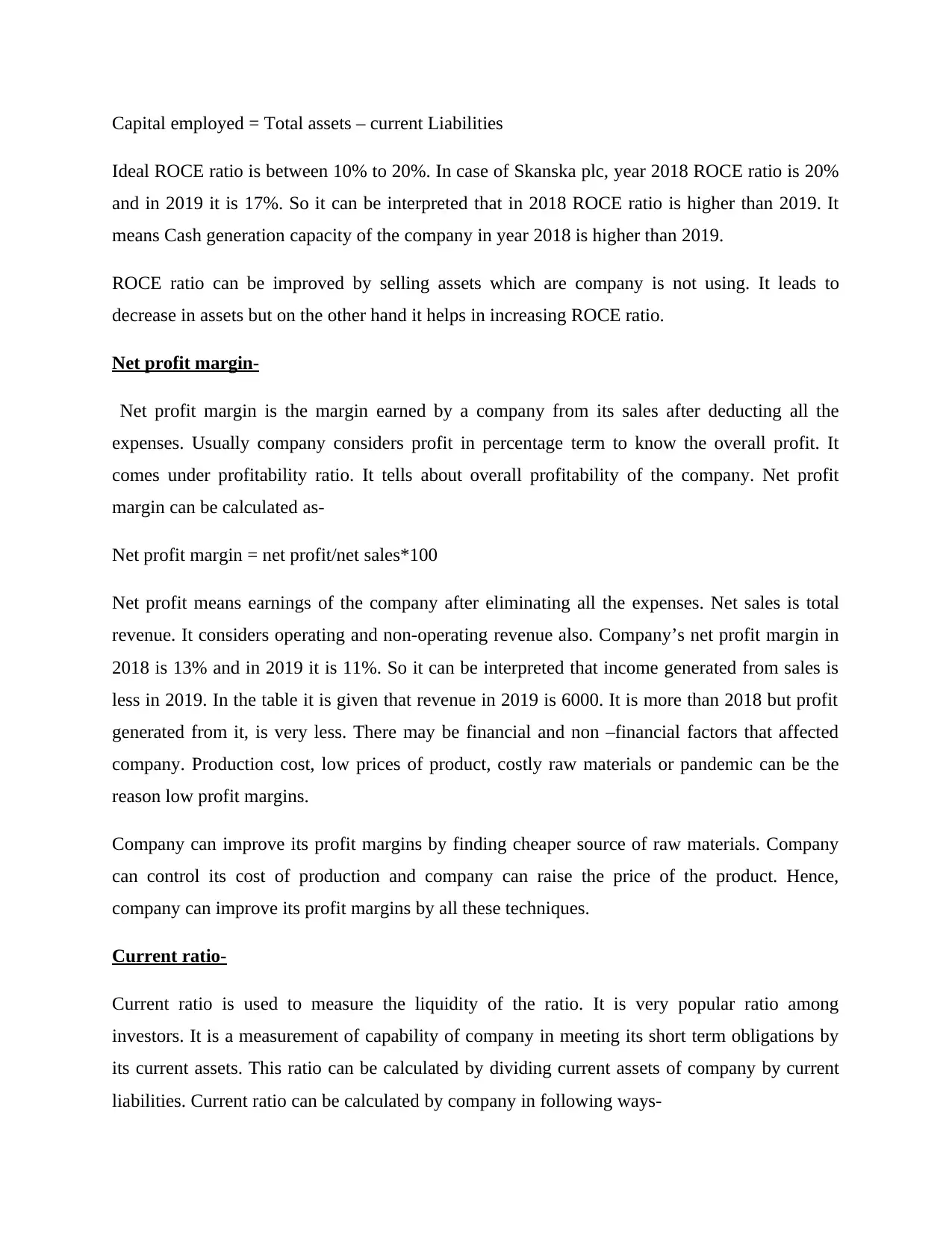
Capital employed = Total assets – current Liabilities
Ideal ROCE ratio is between 10% to 20%. In case of Skanska plc, year 2018 ROCE ratio is 20%
and in 2019 it is 17%. So it can be interpreted that in 2018 ROCE ratio is higher than 2019. It
means Cash generation capacity of the company in year 2018 is higher than 2019.
ROCE ratio can be improved by selling assets which are company is not using. It leads to
decrease in assets but on the other hand it helps in increasing ROCE ratio.
Net profit margin-
Net profit margin is the margin earned by a company from its sales after deducting all the
expenses. Usually company considers profit in percentage term to know the overall profit. It
comes under profitability ratio. It tells about overall profitability of the company. Net profit
margin can be calculated as-
Net profit margin = net profit/net sales*100
Net profit means earnings of the company after eliminating all the expenses. Net sales is total
revenue. It considers operating and non-operating revenue also. Company’s net profit margin in
2018 is 13% and in 2019 it is 11%. So it can be interpreted that income generated from sales is
less in 2019. In the table it is given that revenue in 2019 is 6000. It is more than 2018 but profit
generated from it, is very less. There may be financial and non –financial factors that affected
company. Production cost, low prices of product, costly raw materials or pandemic can be the
reason low profit margins.
Company can improve its profit margins by finding cheaper source of raw materials. Company
can control its cost of production and company can raise the price of the product. Hence,
company can improve its profit margins by all these techniques.
Current ratio-
Current ratio is used to measure the liquidity of the ratio. It is very popular ratio among
investors. It is a measurement of capability of company in meeting its short term obligations by
its current assets. This ratio can be calculated by dividing current assets of company by current
liabilities. Current ratio can be calculated by company in following ways-
Ideal ROCE ratio is between 10% to 20%. In case of Skanska plc, year 2018 ROCE ratio is 20%
and in 2019 it is 17%. So it can be interpreted that in 2018 ROCE ratio is higher than 2019. It
means Cash generation capacity of the company in year 2018 is higher than 2019.
ROCE ratio can be improved by selling assets which are company is not using. It leads to
decrease in assets but on the other hand it helps in increasing ROCE ratio.
Net profit margin-
Net profit margin is the margin earned by a company from its sales after deducting all the
expenses. Usually company considers profit in percentage term to know the overall profit. It
comes under profitability ratio. It tells about overall profitability of the company. Net profit
margin can be calculated as-
Net profit margin = net profit/net sales*100
Net profit means earnings of the company after eliminating all the expenses. Net sales is total
revenue. It considers operating and non-operating revenue also. Company’s net profit margin in
2018 is 13% and in 2019 it is 11%. So it can be interpreted that income generated from sales is
less in 2019. In the table it is given that revenue in 2019 is 6000. It is more than 2018 but profit
generated from it, is very less. There may be financial and non –financial factors that affected
company. Production cost, low prices of product, costly raw materials or pandemic can be the
reason low profit margins.
Company can improve its profit margins by finding cheaper source of raw materials. Company
can control its cost of production and company can raise the price of the product. Hence,
company can improve its profit margins by all these techniques.
Current ratio-
Current ratio is used to measure the liquidity of the ratio. It is very popular ratio among
investors. It is a measurement of capability of company in meeting its short term obligations by
its current assets. This ratio can be calculated by dividing current assets of company by current
liabilities. Current ratio can be calculated by company in following ways-
⊘ This is a preview!⊘
Do you want full access?
Subscribe today to unlock all pages.

Trusted by 1+ million students worldwide
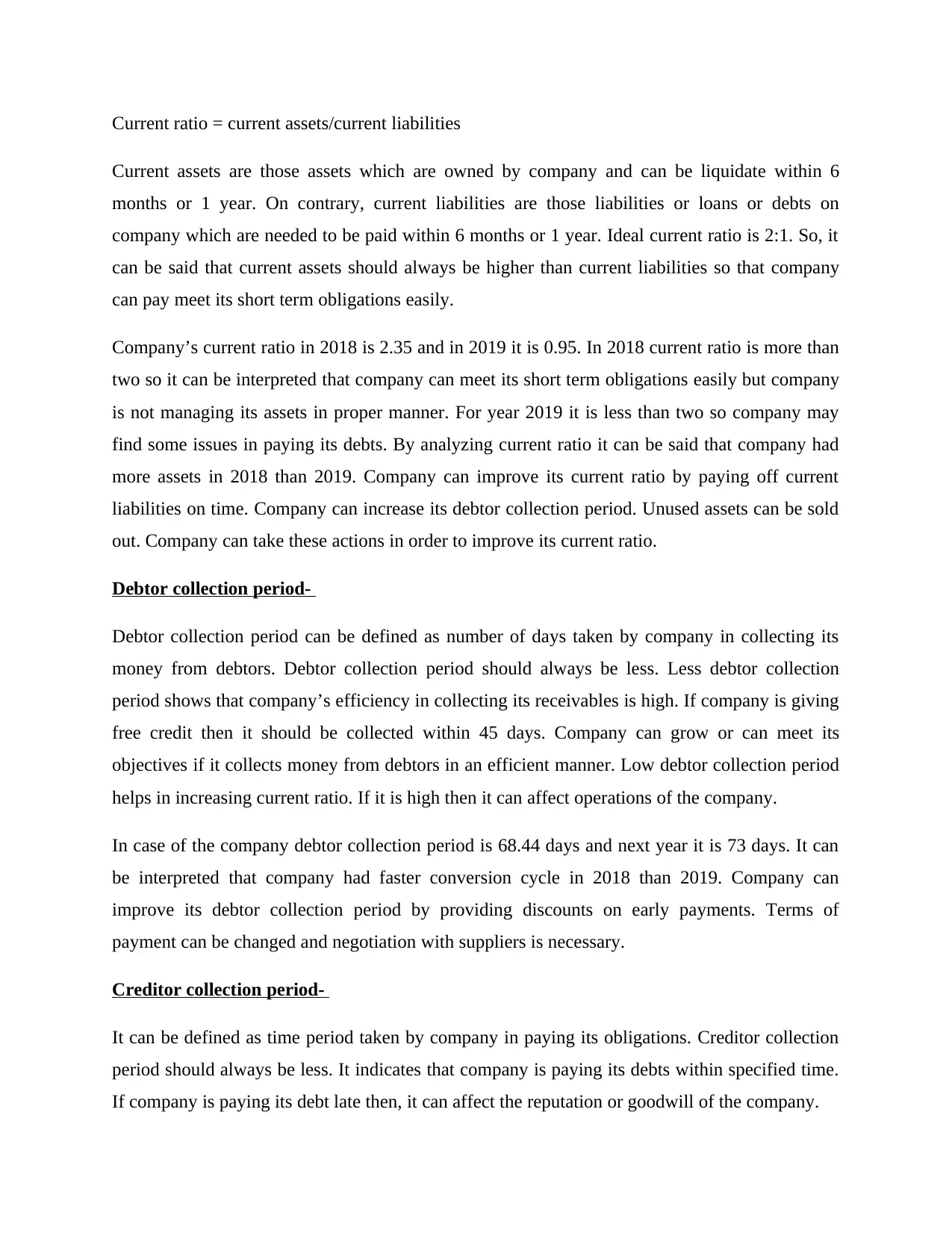
Current ratio = current assets/current liabilities
Current assets are those assets which are owned by company and can be liquidate within 6
months or 1 year. On contrary, current liabilities are those liabilities or loans or debts on
company which are needed to be paid within 6 months or 1 year. Ideal current ratio is 2:1. So, it
can be said that current assets should always be higher than current liabilities so that company
can pay meet its short term obligations easily.
Company’s current ratio in 2018 is 2.35 and in 2019 it is 0.95. In 2018 current ratio is more than
two so it can be interpreted that company can meet its short term obligations easily but company
is not managing its assets in proper manner. For year 2019 it is less than two so company may
find some issues in paying its debts. By analyzing current ratio it can be said that company had
more assets in 2018 than 2019. Company can improve its current ratio by paying off current
liabilities on time. Company can increase its debtor collection period. Unused assets can be sold
out. Company can take these actions in order to improve its current ratio.
Debtor collection period-
Debtor collection period can be defined as number of days taken by company in collecting its
money from debtors. Debtor collection period should always be less. Less debtor collection
period shows that company’s efficiency in collecting its receivables is high. If company is giving
free credit then it should be collected within 45 days. Company can grow or can meet its
objectives if it collects money from debtors in an efficient manner. Low debtor collection period
helps in increasing current ratio. If it is high then it can affect operations of the company.
In case of the company debtor collection period is 68.44 days and next year it is 73 days. It can
be interpreted that company had faster conversion cycle in 2018 than 2019. Company can
improve its debtor collection period by providing discounts on early payments. Terms of
payment can be changed and negotiation with suppliers is necessary.
Creditor collection period-
It can be defined as time period taken by company in paying its obligations. Creditor collection
period should always be less. It indicates that company is paying its debts within specified time.
If company is paying its debt late then, it can affect the reputation or goodwill of the company.
Current assets are those assets which are owned by company and can be liquidate within 6
months or 1 year. On contrary, current liabilities are those liabilities or loans or debts on
company which are needed to be paid within 6 months or 1 year. Ideal current ratio is 2:1. So, it
can be said that current assets should always be higher than current liabilities so that company
can pay meet its short term obligations easily.
Company’s current ratio in 2018 is 2.35 and in 2019 it is 0.95. In 2018 current ratio is more than
two so it can be interpreted that company can meet its short term obligations easily but company
is not managing its assets in proper manner. For year 2019 it is less than two so company may
find some issues in paying its debts. By analyzing current ratio it can be said that company had
more assets in 2018 than 2019. Company can improve its current ratio by paying off current
liabilities on time. Company can increase its debtor collection period. Unused assets can be sold
out. Company can take these actions in order to improve its current ratio.
Debtor collection period-
Debtor collection period can be defined as number of days taken by company in collecting its
money from debtors. Debtor collection period should always be less. Less debtor collection
period shows that company’s efficiency in collecting its receivables is high. If company is giving
free credit then it should be collected within 45 days. Company can grow or can meet its
objectives if it collects money from debtors in an efficient manner. Low debtor collection period
helps in increasing current ratio. If it is high then it can affect operations of the company.
In case of the company debtor collection period is 68.44 days and next year it is 73 days. It can
be interpreted that company had faster conversion cycle in 2018 than 2019. Company can
improve its debtor collection period by providing discounts on early payments. Terms of
payment can be changed and negotiation with suppliers is necessary.
Creditor collection period-
It can be defined as time period taken by company in paying its obligations. Creditor collection
period should always be less. It indicates that company is paying its debts within specified time.
If company is paying its debt late then, it can affect the reputation or goodwill of the company.
Paraphrase This Document
Need a fresh take? Get an instant paraphrase of this document with our AI Paraphraser
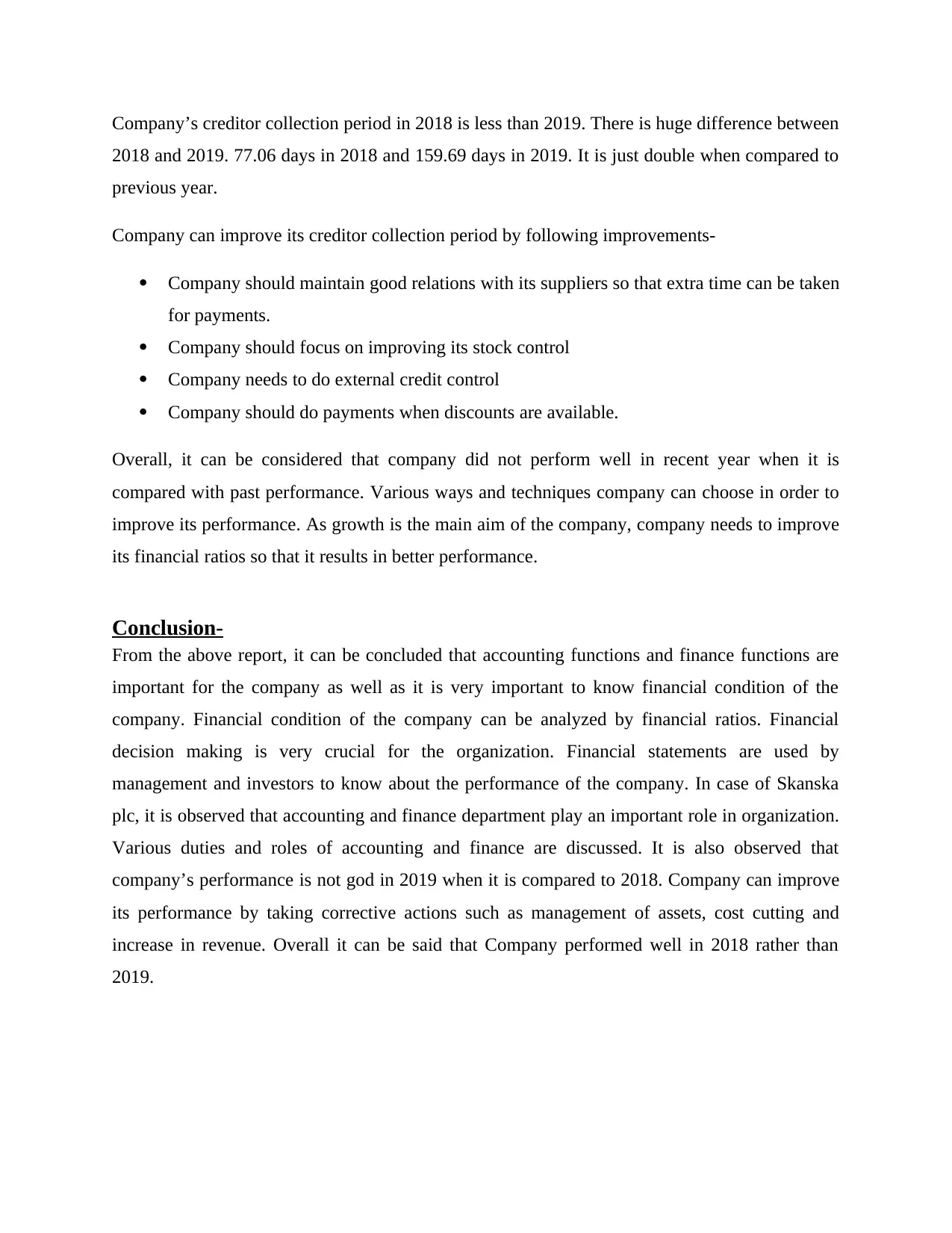
Company’s creditor collection period in 2018 is less than 2019. There is huge difference between
2018 and 2019. 77.06 days in 2018 and 159.69 days in 2019. It is just double when compared to
previous year.
Company can improve its creditor collection period by following improvements-
Company should maintain good relations with its suppliers so that extra time can be taken
for payments.
Company should focus on improving its stock control
Company needs to do external credit control
Company should do payments when discounts are available.
Overall, it can be considered that company did not perform well in recent year when it is
compared with past performance. Various ways and techniques company can choose in order to
improve its performance. As growth is the main aim of the company, company needs to improve
its financial ratios so that it results in better performance.
Conclusion-
From the above report, it can be concluded that accounting functions and finance functions are
important for the company as well as it is very important to know financial condition of the
company. Financial condition of the company can be analyzed by financial ratios. Financial
decision making is very crucial for the organization. Financial statements are used by
management and investors to know about the performance of the company. In case of Skanska
plc, it is observed that accounting and finance department play an important role in organization.
Various duties and roles of accounting and finance are discussed. It is also observed that
company’s performance is not god in 2019 when it is compared to 2018. Company can improve
its performance by taking corrective actions such as management of assets, cost cutting and
increase in revenue. Overall it can be said that Company performed well in 2018 rather than
2019.
2018 and 2019. 77.06 days in 2018 and 159.69 days in 2019. It is just double when compared to
previous year.
Company can improve its creditor collection period by following improvements-
Company should maintain good relations with its suppliers so that extra time can be taken
for payments.
Company should focus on improving its stock control
Company needs to do external credit control
Company should do payments when discounts are available.
Overall, it can be considered that company did not perform well in recent year when it is
compared with past performance. Various ways and techniques company can choose in order to
improve its performance. As growth is the main aim of the company, company needs to improve
its financial ratios so that it results in better performance.
Conclusion-
From the above report, it can be concluded that accounting functions and finance functions are
important for the company as well as it is very important to know financial condition of the
company. Financial condition of the company can be analyzed by financial ratios. Financial
decision making is very crucial for the organization. Financial statements are used by
management and investors to know about the performance of the company. In case of Skanska
plc, it is observed that accounting and finance department play an important role in organization.
Various duties and roles of accounting and finance are discussed. It is also observed that
company’s performance is not god in 2019 when it is compared to 2018. Company can improve
its performance by taking corrective actions such as management of assets, cost cutting and
increase in revenue. Overall it can be said that Company performed well in 2018 rather than
2019.
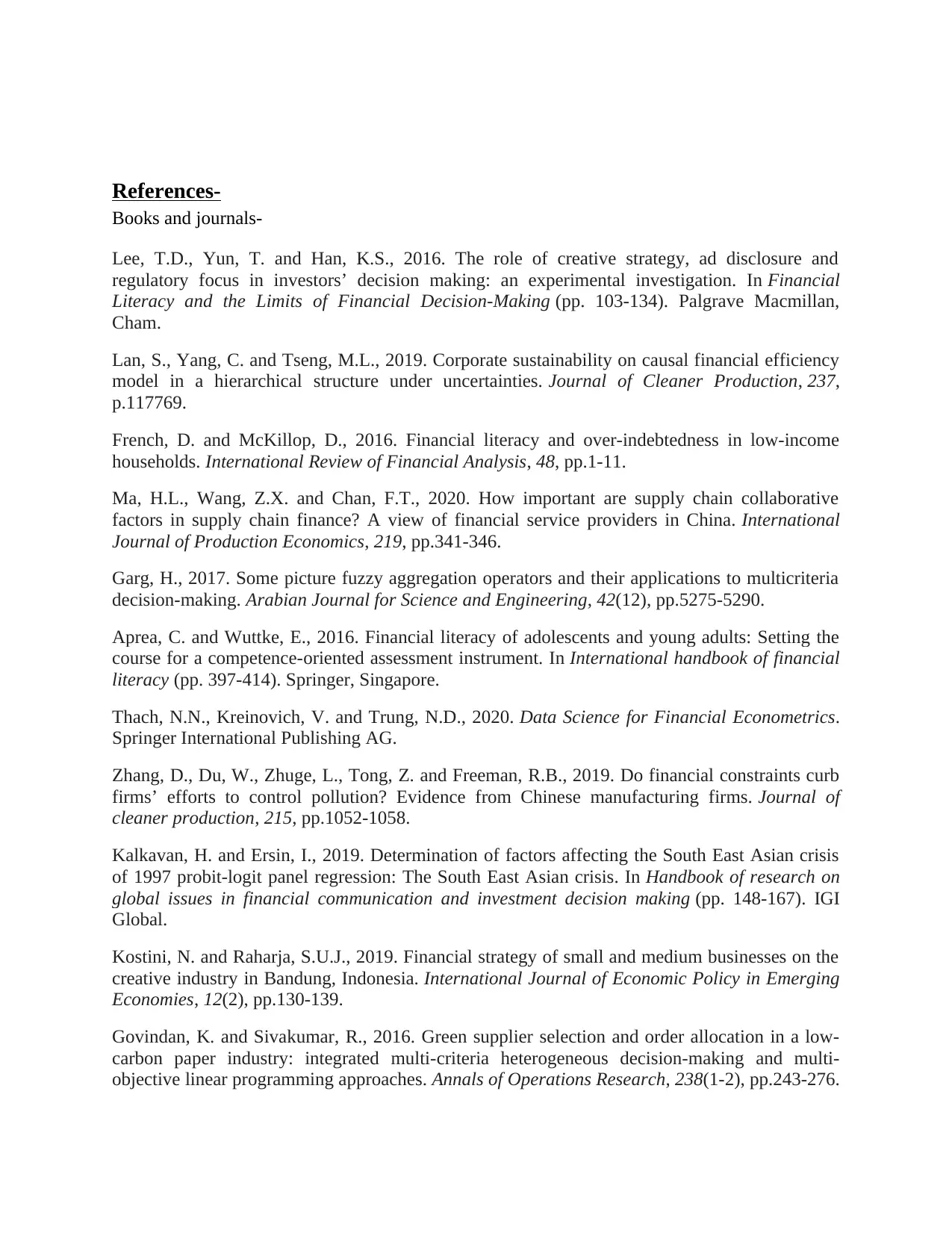
References-
Books and journals-
Lee, T.D., Yun, T. and Han, K.S., 2016. The role of creative strategy, ad disclosure and
regulatory focus in investors’ decision making: an experimental investigation. In Financial
Literacy and the Limits of Financial Decision-Making (pp. 103-134). Palgrave Macmillan,
Cham.
Lan, S., Yang, C. and Tseng, M.L., 2019. Corporate sustainability on causal financial efficiency
model in a hierarchical structure under uncertainties. Journal of Cleaner Production, 237,
p.117769.
French, D. and McKillop, D., 2016. Financial literacy and over-indebtedness in low-income
households. International Review of Financial Analysis, 48, pp.1-11.
Ma, H.L., Wang, Z.X. and Chan, F.T., 2020. How important are supply chain collaborative
factors in supply chain finance? A view of financial service providers in China. International
Journal of Production Economics, 219, pp.341-346.
Garg, H., 2017. Some picture fuzzy aggregation operators and their applications to multicriteria
decision-making. Arabian Journal for Science and Engineering, 42(12), pp.5275-5290.
Aprea, C. and Wuttke, E., 2016. Financial literacy of adolescents and young adults: Setting the
course for a competence-oriented assessment instrument. In International handbook of financial
literacy (pp. 397-414). Springer, Singapore.
Thach, N.N., Kreinovich, V. and Trung, N.D., 2020. Data Science for Financial Econometrics.
Springer International Publishing AG.
Zhang, D., Du, W., Zhuge, L., Tong, Z. and Freeman, R.B., 2019. Do financial constraints curb
firms’ efforts to control pollution? Evidence from Chinese manufacturing firms. Journal of
cleaner production, 215, pp.1052-1058.
Kalkavan, H. and Ersin, I., 2019. Determination of factors affecting the South East Asian crisis
of 1997 probit-logit panel regression: The South East Asian crisis. In Handbook of research on
global issues in financial communication and investment decision making (pp. 148-167). IGI
Global.
Kostini, N. and Raharja, S.U.J., 2019. Financial strategy of small and medium businesses on the
creative industry in Bandung, Indonesia. International Journal of Economic Policy in Emerging
Economies, 12(2), pp.130-139.
Govindan, K. and Sivakumar, R., 2016. Green supplier selection and order allocation in a low-
carbon paper industry: integrated multi-criteria heterogeneous decision-making and multi-
objective linear programming approaches. Annals of Operations Research, 238(1-2), pp.243-276.
Books and journals-
Lee, T.D., Yun, T. and Han, K.S., 2016. The role of creative strategy, ad disclosure and
regulatory focus in investors’ decision making: an experimental investigation. In Financial
Literacy and the Limits of Financial Decision-Making (pp. 103-134). Palgrave Macmillan,
Cham.
Lan, S., Yang, C. and Tseng, M.L., 2019. Corporate sustainability on causal financial efficiency
model in a hierarchical structure under uncertainties. Journal of Cleaner Production, 237,
p.117769.
French, D. and McKillop, D., 2016. Financial literacy and over-indebtedness in low-income
households. International Review of Financial Analysis, 48, pp.1-11.
Ma, H.L., Wang, Z.X. and Chan, F.T., 2020. How important are supply chain collaborative
factors in supply chain finance? A view of financial service providers in China. International
Journal of Production Economics, 219, pp.341-346.
Garg, H., 2017. Some picture fuzzy aggregation operators and their applications to multicriteria
decision-making. Arabian Journal for Science and Engineering, 42(12), pp.5275-5290.
Aprea, C. and Wuttke, E., 2016. Financial literacy of adolescents and young adults: Setting the
course for a competence-oriented assessment instrument. In International handbook of financial
literacy (pp. 397-414). Springer, Singapore.
Thach, N.N., Kreinovich, V. and Trung, N.D., 2020. Data Science for Financial Econometrics.
Springer International Publishing AG.
Zhang, D., Du, W., Zhuge, L., Tong, Z. and Freeman, R.B., 2019. Do financial constraints curb
firms’ efforts to control pollution? Evidence from Chinese manufacturing firms. Journal of
cleaner production, 215, pp.1052-1058.
Kalkavan, H. and Ersin, I., 2019. Determination of factors affecting the South East Asian crisis
of 1997 probit-logit panel regression: The South East Asian crisis. In Handbook of research on
global issues in financial communication and investment decision making (pp. 148-167). IGI
Global.
Kostini, N. and Raharja, S.U.J., 2019. Financial strategy of small and medium businesses on the
creative industry in Bandung, Indonesia. International Journal of Economic Policy in Emerging
Economies, 12(2), pp.130-139.
Govindan, K. and Sivakumar, R., 2016. Green supplier selection and order allocation in a low-
carbon paper industry: integrated multi-criteria heterogeneous decision-making and multi-
objective linear programming approaches. Annals of Operations Research, 238(1-2), pp.243-276.
⊘ This is a preview!⊘
Do you want full access?
Subscribe today to unlock all pages.

Trusted by 1+ million students worldwide
1 out of 13
Related Documents
Your All-in-One AI-Powered Toolkit for Academic Success.
+13062052269
info@desklib.com
Available 24*7 on WhatsApp / Email
![[object Object]](/_next/static/media/star-bottom.7253800d.svg)
Unlock your academic potential
Copyright © 2020–2025 A2Z Services. All Rights Reserved. Developed and managed by ZUCOL.





